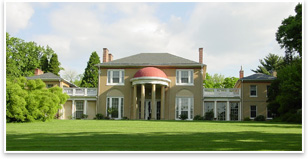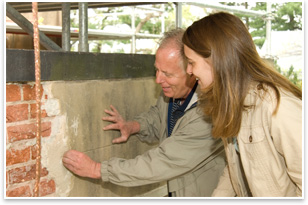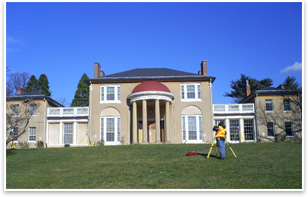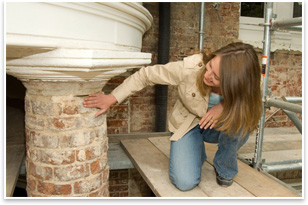
| Tudor Place: Democracy Starts at Home Peeling back the layers of a Neoclassical masterpiece and the architectural ideals that surround it How do you . . . use structure modeling technology and historical archives to restore a residence?
As a town so solidly rooted in 19th-century architecture, Washington, D.C., has no lack of Neoclassical flourishes—wide domes, stately columns, magnificent distances, and egalitarian symmetry. But almost as a rule, this isn’t seen in residences. The rapid pace of urban resettlement and renovation has taken its toll on the District of Columbia as it has in any city, leaving few residential relics of that era. Tudor Place, Georgetown’s 200-year-old former home of the grandchildren of Martha Washington, is among the most significant early 19th-century residences in Washington and is receiving its first major renovation since 1914. The iconic home was designed by William Thornton, who created the first design for the U.S. Capitol and designed The Octagon House, now owned and operated as a museum by the American Architectural Foundation.
The old stucco has been successfully removed, and the next step for Tudor Place is to have the muted gold sandstone stucco of 1914 replaced. Aiding this historic reconstruction are the extensive archival documents the museum houses. These include personal letters, financial documents, and original construction diagrams, many dating back to the Washingtons themselves. All of these have helped the museum staff peel away the layers of history and accurately interpret the history of Tudor Place—a history that has had to rely on anecdotal evidence for too long. “The more you know about the materials you’re dealing with, the better you’re able to estimate costs of the project and the possible surprises that might come up,” says Jana Shafagoj, the site’s architectural historian.
Expression of democratic ideals
Charles Atherton, the late chief administrative officer of the U.S. Commission of Fine Arts, recognized Thornton’s and Jefferson’s contributions as singularly vital links to history. “What other architects of other great homes have such a singular connection with the beginning of this country?” he asked. “One and only one comes to mind: Jefferson and his Monticello.”
Though surrounded by such priceless artifacts, Shafagoj’s conservation mission isn’t stuck in any particular era. The historical period of conservation for the Tudor Place is from 1816 to 1983—the entire period when generations of the Peter family lived there. This means preserving the stucco on the walls as well as the bidet in the bathroom. “Something that was installed here in 1816 is just as important as something installed in 1982,” says Shafagoj. |
||
Copyright 2007 The American Institute of Architects. All rights reserved. Home Page |
||
news headlines
practice
business
design
Captions
Image 1: Tudor Place just prior to having it’s latest layer of stucco stripped away.
Image 2: Jana Shafagoj watches as the original brickwork of the house is revealed.
Image 3: Tudor Place just prior to having it’s latest layer of stucco stripped away.
Image 4: Cyark’s “point cloud” diagram.
Image 5: Jana Shafagoj rubs the salt accumulated from years of water damage off a column.


 Layer by layer
Layer by layer Shafagoj will also be aided by 3D-photogrammetry technology, provided by Cyark, a digital documentation company. This uses a laser to scan the exterior and interior of the building to produce a microscopically accurate 3D model of everything, including the exposed brick faces, visible for the first time since construction. “Instead of looking only at one elevation of the building, this creates the whole house so you can really turn it and examine how different portions of interrelate with each other,” Shafagoj says.
Shafagoj will also be aided by 3D-photogrammetry technology, provided by Cyark, a digital documentation company. This uses a laser to scan the exterior and interior of the building to produce a microscopically accurate 3D model of everything, including the exposed brick faces, visible for the first time since construction. “Instead of looking only at one elevation of the building, this creates the whole house so you can really turn it and examine how different portions of interrelate with each other,” Shafagoj says.
 A broad conservation period
A broad conservation period